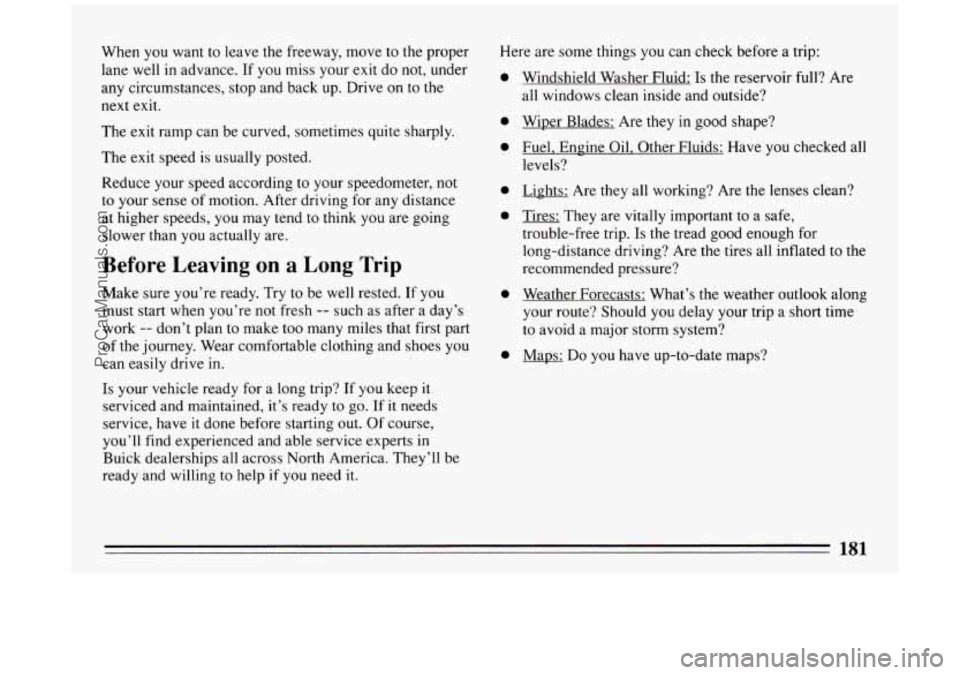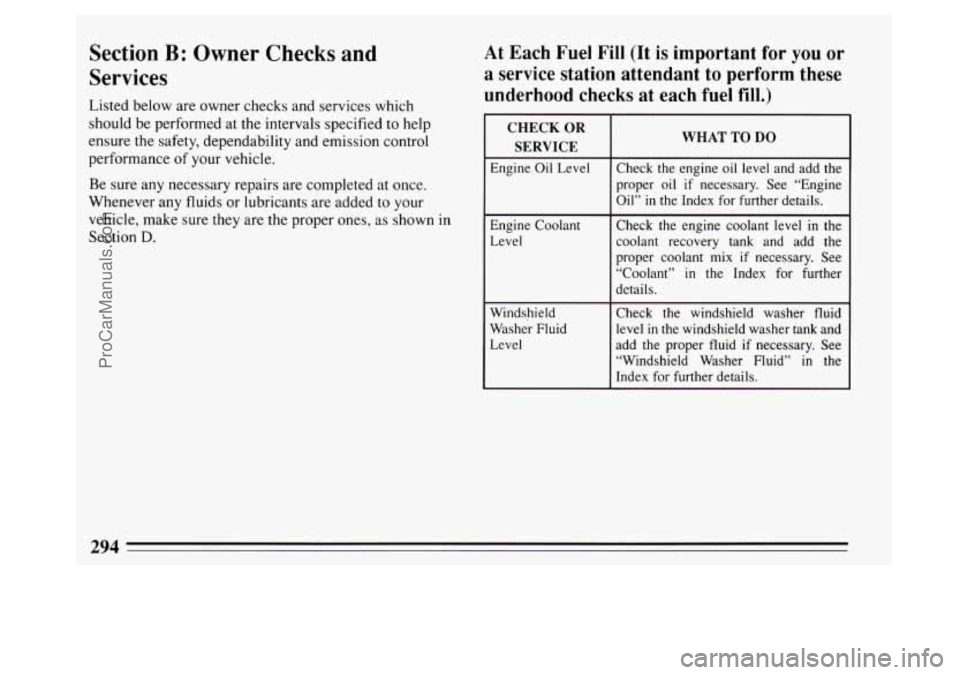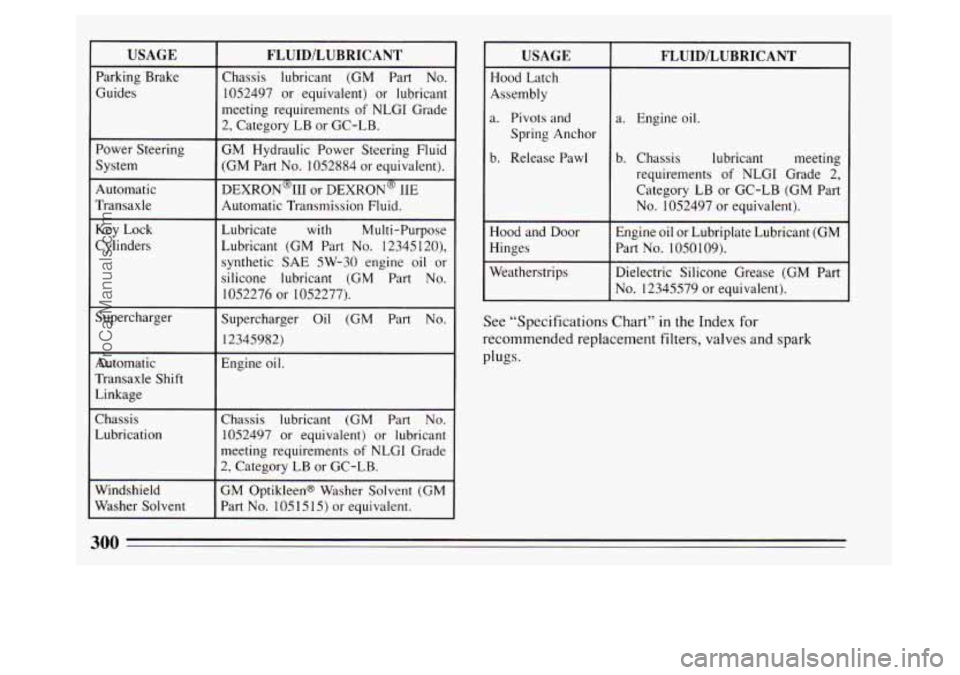Page 99 of 324
Windshield Washer
At the top of the multifunction lever there’s a paddle
with the word “PUSH” on it. To spray washer fluid on
the windshield, push the paddle for less than a second.
The washer will spray several times, then stop. Unless
they are already turned
on, the wipers will operate at
low speed for several sweeps, then turn
off.
To get more fluid on the windshield, push .and hold the
paddle. Spraying will continue as long as the paddle is
held.
WASHER
FLUID LOW
If this light comes on,
it means you’re low on
washer fluid. Driving
without washer fluid can be dangerous.
A bad
mud splash can block your vision.
You could hit another
vehicle or go
off the road. Check your washer fluid level
often.
97
ProCarManuals.com
Page 100 of 324
NOTICE:
When using concentrated washer fluid,
follow the manufacturer’s instructions for
adding water.
0 Don’t mix water with ready-to use washer
fluid. Water can cause the solution to
freeze and damage your washer fluid tank
and other parts
of the washer system. Also,
water doesn’t clean as well as washer fluid.
0 Fill your washer fluid tank only 3/4 full
when it’s very cold. This allows for
expansion, which could damage the tank
if
it is completely full.
windshield washer. It can damage your
paint.
Don’t use radiator antifreeze in your
Cruise Control
1
With Cruise Control, you
can maintain a speed
of
about 25 mph (40 km/h) or
more without keeping your
foot on the accelerator. This
can really help on long
trips. Cruise Control does
not work at speeds below
about
25 mph (40 km/h).
When you apply your brakes, the Cruise Control shuts
off.
98
ProCarManuals.com
Page 183 of 324

When you want to leave the freeway, move to the proper
lane well
in advance. If you miss your exit do not, under
any circumstances, stop and back up. Drive on to the
next
exit.
The exit ramp can be curved, sometimes quite sharply.
The exit speed
is usually posted.
Reduce your speed according to your speedometer, not
to your sense of motion. After driving for any distance
at higher speeds, you may tend to think you are going
slower than you actually are.
Before Leaving on a Long Trip
Make sure
you’re ready. Try to be well rested. If you
must start when you’re not fresh
-- such as after a day’s
work
-- don’t plan to make too many miles that first part
of the journey. Wear comfortable clothing and shoes you
can easily drive in.
Is your vehicle ready for a long trip? If you keep it
serviced and maintained, it’s ready to go. If it needs
service, have it done before starting out.
Of course,
you’ll find experienced and able service experts in
Buick dealerships all across North America. They’ll be
ready and willing to help
if you need it.
Here are some things you can check before a trip:
0
0
0
0
0
0
0
Windshield Washer Fluid: Is the reservoir full? Are
all windows clean inside and outside?
Wiper Blades: Are they
in good shape?
Fuel, Engine Oil, Other Fluids: Have you checked all
levels?
Lights: Are they all working? Are
the lenses clean?
Tires: They are vitally important
to a safe,
trouble-free trip.
Is the tread good enough for
long-distance driving? Are the tires all inflated to the
recommended pressure?
Weather Forecasts: What’s the weather outlook along
your route? Should
you delay your trip a short time
to avoid a major storm system?
Maps:
Do you have up-to-date maps?
181
ProCarManuals.com
Page 186 of 324
Here are some tips for winter driving:
Have your Buick in good shape for winter. Be sure
your engine coolant mix is correct.
You may want to put winter emergency supplies in
your trunk. Include
an ice scraper, a small brush or broom, a supply
of windshield washer fluid, a rag, some winter outer
clothing, a small shovel, a flashlight, a red cloth, and a
couple
of reflective warning triangles. And, if you will
be driving under severe conditions, include a small bag
of sand, a piece of old carpet or a couple of burlap bags
.to help provide traction.
Be sure you properly secure
these items in your vehicle.
184
ProCarManuals.com
Page 229 of 324

Part 6 Service and Appearance Care
Here you will find information about the care of your Buick . This part begins with service and fuel information. and
then
it shows how to check important fluid and lubricant levels . There is also technical information about your
vehicle. and a section devoted to its appearance care
.
Part 6 includes:
Service ........................................................................\
.. 228
Fuel
........................................................................\
..... 229
HoodRelease
..................................................................... 234
Engineoil
....................................................................... \
238
Aircleaner
....................................................................... \
243
Automatic Transaxle Fluid
........................................................... 244
Enginecoolant
.................................................................... 247
PowerSteeringFluid ............................................................... 250
Windshield Washer Fluid
............................................................ 251
Brakes
........................................................................\
... 252
Battery
........................................................................\
.. 255
BulbReplacement
................................................................. 256
Loading Your Vehicle
............................................................... 258
Tires
........................................................................\
.... 260
Appearancecare
.................................................................. 268
Vehicle Identification Number (VIN) .................................................. 276
FusesandCircuitBreakers
........................................................... 277
Capacities and Specifications
......................................................... 282
227
ProCarManuals.com
Page 253 of 324
Windshield Washer Fluid
To Add
Open the cap labeled
“WASHER
FLUID ONLY.”
Add washer fluid until the
bottle
is full.
~ ~ NOTICE:
~ When using concentrated washer fluid,
~ follow the manufacturer’s instructions for
~ adding water.
Don’t mix water with ready-to-use washer
fluid. Water can cause the solution
to
freeze and damage your washer fluid tank
and other parts of the washer system.
Also,
water doesn’t clean as well as washer fluid.
Fill your washer fluid tank only 3/4 full
when it’s very cold. This allows for
expansion, which could damage the tank
if
it is completely full.
windshield washer.
It can damage your
washer system and paint.
Don’t use radiator antifreeze in your
251
ProCarManuals.com
Page 296 of 324

Section B: Owner Checks and
Services
Listed below are owner checks and services which
should be performed at the intervals specified to help
ensure
the safety, dependability and emission control
performance of your vehicle.
Be sure any necessary repairs are completed at once.
Whenever any fluids or lubricants are added to your
vehicle, make sure they are the proper ones, as shown in
Section
D.
At Each Fuel Fill (It is important for you or
a service station attendant to perform these
underhood checks at each fuel
fill.)
Engine Oil Level
Engine Coolant
Level
Washer Fluid
Level
WHAT TO DO
Check the engine oil level and add the
proper oil
if necessary. See “Engine
Oil” in the Index for further details.
Check the engine coolant level
in the
coolant recovery tank and add the
proper coolant mix
if necessary. See
“Coolant”
in the Index for further
details.
Check the windshield washer fluid
level
in the windshield washer tank and
add the proper fluid
if necessary. See
“Windshield Washer Fluid”
in the
Index for further details.
294
ProCarManuals.com
Page 302 of 324

USAGE
Parking Brake
Guides
Power Steering
System
Automatic
Transaxle
Key Lock
Cylinders
Supercharger
Automatic
Transaxle Shift
Linkage
Chassis
Lubrication
Windshield
Washer Solvent
FLUID/LUBRICANT
Chassis lubricant (GM Part No.
1052497 or equivalent) or lubricant
meeting requirements of NLGI Grade
2, Category LB or GC-LB.
GM Hydraulic Power Steering Fluid
(GM Part
No. 1052884 or equivalent).
DEXRON~II or DEXRON~ IIE
Automatic Transmission Fluid.
Lubricate with Multi-Purpose
Lubricant (GM Part
No. 12345120),
synthetic SAE 5W-30 engine
oil or
silicone lubricant (GM Part
No.
1052276 or 1052277).
Supercharger Oil (GM Part
No.
12345982)
Engine oil.
Chassis lubricant (GM Part
No.
1052497 or equivalent) or lubricant
meeting requirements
of NLGI Grade
2, Category LB
or GC-LB.
GM OptikleenB Washer Solvent (GM
Part
No. 105 15 15) or equivalent.
USAGE
Hood Latch
Assembly
a. Pivots and
Spring Anchor
b. Release Pawl
Hood and Door
Hinges
Weatherstrips
FLUID/LUBRICANT
a. Engine oil.
b. Chassis lubricant meeting
requirements of NLGI Grade
2,
Category LB or GC-LB (GM Part
No. 1052497 or equivalent).
Engine oil or Lubriplate Lubricant (GM
Part
No. 1050109).
Dielectric Silicone Grease (GM Part
No. 12345579 or equivalent).
See “Specifications Chart” in the Index for
recommended replacement filters, valves and spark
plugs.
300
ProCarManuals.com